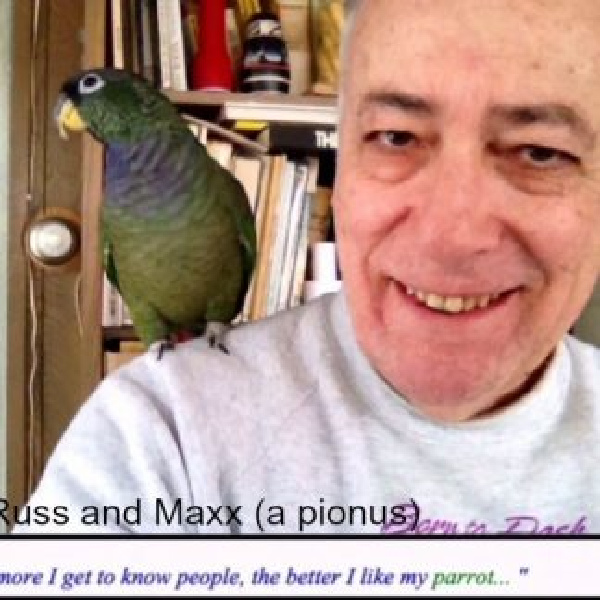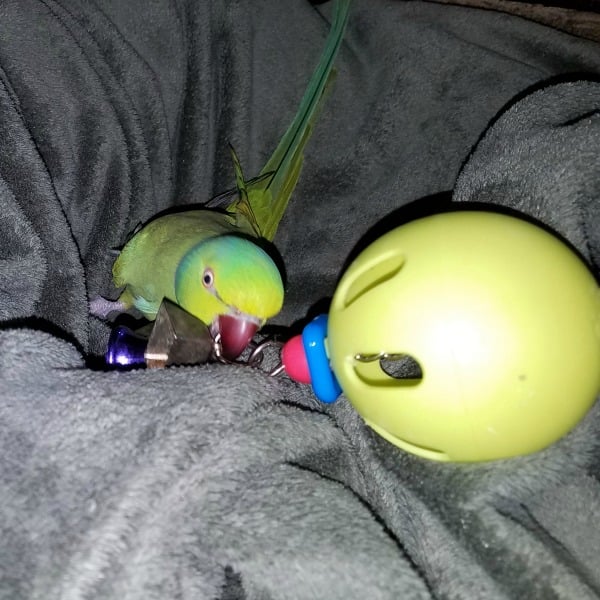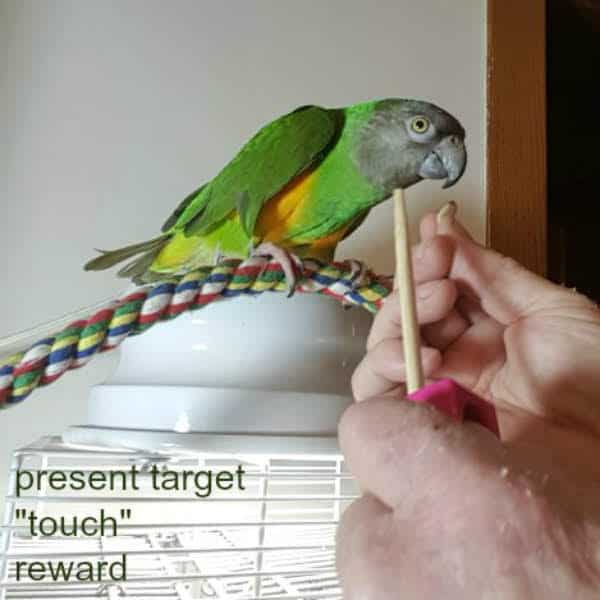
Should We Anesthetize Birds for Exams and Blunt Their Beaks?
Last Updated on by Mitch Rezman
The following comment is in reference to a blog post entitled “How To Stop An Indian Ringneck Parrot From Biting“
Russ commented:
FIRST OFF, Blunt Keto’s beak at the vet.
My vet is Scott McDonald, who puts all birds under gas for examination & grooming (STRESS FREEEEE).
His clinics are several per month in his Clarendon Hills home.
The best of the best.
SECOND: as with my 15y.o. Pionus, teach Ketto the difference between GOOD & BAD (or NO GOOD), by saying REPEATEDLY OVER & OVER AGAIN & AGAIN “Good Boy!”
Every single time Keto does something good.
And say “Bad Bird” every time he nips or does something bad. OR, say “don’t you do that” with my palm flat in his face giving the body language signal to STOP DOING THAT.
Now, walk away from Keto after saying ‘bad bird’ and cease giving him attention.
Works so well after 6 months thru 15 years, that now my Maxx says back to me “don’t you do dat” when he means just what the words say!!!!
And I’m no behavior expert, just a considerate Mentor, Companion, Sentinel, extraordinarily happy birdman.
RussD
My response
Russ
All your ideas are valid.
Anyone following me for the past 10 or 15 years would see that your views do not align with mine.
Editor’s note: While I take everything into consideration, my point of view is constructed based on interacting with tens of thousands of cage bird keepers over the past 15 years providing me with what I call my 360° field of vision on pet bird care.
To that point:
I will not blunt a bird’s beak which handicaps their eating and climbing abilities.
My stance is that It’s irresponsible for a veterinarian to blunt any bird’s beak unless it was malformed from improper hand-feeding technique or too great a seed diet for certain species like Eclectus parrots.
The beak is filled with thousands of nerve endings (Corpuscles of Herbst).
Trimming a bird’s beak also reduces sensitivity.
I will not clip a bird’s wings (except for early flight training) which precludes their ability to fly and maintain balance.
Caged birds with clipped wings and recent zygodactyl pedicures are far more likely to injure themselves from falling high in a birdcage triggered by night frights.
Humans have been involved with pet birds for roughly 1000 years.
Before birds became pets they had been around for close to 100 million years.
Enforcing human values contradicts eons of captive bird’s “instinctual expectations”.
If we could control our birds with simple things like beak blunting and wing clipping, rescues would not be overflowing with unwanted captive parrots.
Veterinarians have yet to figure out how to prevent chronic egg laying, feather destruction and screaming for caged birds.
Dr. McDonald even took the time to spell out the precise case size for many species of birds.
Lupron has caused serious medical issues for more than 10,000 women,
Everything from tooth enamel delamination to fibromyalgia.
The biggest single response I get from humans and human veterinarians is that “birds are not like people at all” so that I can have the same reaction”.
I get that but by your interpretation, it’s okay to give bird narcotics, rat poison, I mean where’s the master list of what’s OK for birds but not humans?
Veterinarians and rescues endorse the use of Haldol for screaming and feather plucking reduction.
Haldol is a psychotropic drug used to help bipolar individuals and schizophrenics control their disease.
So you end up taking a brilliant animal and turning it into a zombie slave of the drug creating nothing more than a dazed and confused albeit quiet animal.
I’ve reached out to dozens of veterinarians (blogging repeatedly) asking specifically how many lumens are necessary for a bird to process vitamin D3?
Although veterinarians have extensive scientific training they all seem to get stuck when t I ask the question based upon something called the “inverse square law of light”
Simply put, a 15,000 lm bulb gives off 15,000 lm at the surface of the bulb.
Place an object 20 inches away from the same bowl and the object received 700 lm.
What’s the right dosage, doc?
Follow-up question, if light must be absorbed through the skin how does light pass through the feathers in order to make this assimilation actually work?
Not one veterinarian has ever responded directly to these questions via email, forums or replies on any of their blogs.
I’ve literally asked thousands of people over the years,
“Has your veterinarian ever asked you about the setup of your bird cage?
“Is he or she interested in the types of approaches you used and where these cage accessories are placed in the cage?
Besides recommending a pelleted diet what other nutritional discussions have they had with you.
“Fresh fruits and vegetables!”
That’s all well and good but oranges and as well as citrus, in general, can be screaming and plucking triggers.
Food remains in a bird’s crop for up to six hours.
This allows birds in the wild to regurgitate everything in order for faster “get away” from danger.
Humans get heartburn even as the esophagus pushes food down.
We humans take an antacid to help offset acids indigestion.
Imagine that burn for six hours.
Birds can’t tell you they are in pain so they pluck at their chest trying to make the pain go away having no other choice
Veterinarians in America do not get formal nutrition nor behavioral education thus they are all guessing just like the rest of us.
So what we end up with are “behavioral experts” many use warm hand feeding formula to help lead the bird to achieve expected behavioral outcomes.
We have bird whisperers and any number of experts on the Internet, especially you to providing 10 STEPS TO STOP YOUR BIRD FROM BITING.
The problem is birds never see these videos nor read the articles
I would never put a bird “under” for a simple wellness examination any more than I would ask my doctor to put me out or for a vet to anesthetize a dog for the same reason.
Any time an animal be it avian or mammal goes under you increase the risk for something to possibly go wrong.
I don’t understand why that is done.
It also ignores the fact that nobody is willing to handle the bird for an examination at home.
If your bird gets injured or sick and a vet is not available a human in the household should be able to wrap the bird with a towel then restrain it for an examination.
What if your birds get a blood feather during a molt?
The bird could bleed out long before you make it to the vet.
How many cage bird keepers reading this know how to safely restrain a bird and pull a blood feather out to prevent blood loss?
This is something we preach regularly and something that must be practiced so when an ad hoc examination is needed, the bird’s already used to the process.
What’s the probability of your bird getting a single blood feather in its lifetime?
Let’s look at the math.
Conservatively a hookbill has about 6000 feathers.
30 years and 30 molts mean that the bird in your cage is going to replace about 180,000 feathers.
What’s the possibility of one of those feathers breaking (becoming a blood feather) over 30 years?
Think about that.
Restraints are not always stressed free, but sometimes it’s essential.
We offer avian restraints designed by Greg Burkett, DVM, DAVBP (avian practice), a specialist in avian medicine and surgery.
A properly socialized bird should not be stressed by a physical exam.
Transferring a bird into a travel carrier may be a stress point for the bird.
Being handled by strangers may be a stress point for the bird.
Waking up from anesthesia in a strange place may be a stress point for the bird.
To say that an anesthesia bird passes an examination stress-free is an oversimplification, Russ.
I don’t disagree with your “STOP DOING THAT” method.
But there’s more to it in that one has to learn how to avoid the bite altogether.
Although Keto’s out of the cage from roughly 7:30 till 10 or 11 every morning and 5:15 till 7:30 (DST) every evening, Catherine makes a point of bringing him onto her lap with a blanket or towel using his bell as a distraction and she never gets bit.

All of her talking is positive in a high voice,
Keto enjoys the heck out of this effective socialization method.
I make a point of giving him a small piece of walnuts several times a day which he really likes.
Currently, I have not been bitten for about four weeks
That has led to Keto landing on me, Catherine, and more recently a visitor.
We shoo him off rather quickly (dipping the shoulder or waving the arm is enough now) and nobody has gotten bitten which was not the case two months ago.
Keto is clearly beginning to mellow.
In conclusion, Russ, as a committed pet bird companion you’ve had a 15-year relationship with a single Pionus.
Keto, as a counterpoint came into our home, now all of two months ago with a sketchy history of having been in relationships with 3 to 5 other households over somewhere between 15 and 20 years.
Thus it’s important to take into consideration the history of a bird’s inside the cage and outside of the cage environments while looking at both, holistically helping us to know what to do moving forward when interacting with any bird in your home.
best
mitchr
Author Profile
Latest entries
 The Traveling BirdJune 26, 2025Can You Name 5 Parrot Species That Are Living Wild in the USA?
The Traveling BirdJune 26, 2025Can You Name 5 Parrot Species That Are Living Wild in the USA? Bird BehaviorJune 26, 2025How is it Parrots Are Problem Solvers Social Animals and Even Use Tools?
Bird BehaviorJune 26, 2025How is it Parrots Are Problem Solvers Social Animals and Even Use Tools? Bird & Parrot AnatomyJune 25, 2025How a Tiny Chemical Modification Makes Parrots Nature’s Living Paintings
Bird & Parrot AnatomyJune 25, 2025How a Tiny Chemical Modification Makes Parrots Nature’s Living Paintings PigeonsJune 20, 2025How Do Parrots Thrive in Cities Outside Their Native Habitats?
PigeonsJune 20, 2025How Do Parrots Thrive in Cities Outside Their Native Habitats?
This Post Has 8 Comments
Leave a Reply
You must be logged in to post a comment.



Bert
9 Dec 2018I have three parrots, all Eclectus. Annually or better, they all get beaks and nails tended. My flighted boy has a chronic issue with beak overgrowth and deformation, the vet keeps him aligned and able to eat and all that, she’s a pro with that dremel, the process takes 5 minutes, the bird doesn’t enjoy it so much, but it keeps the point and the lower edges such that there’s no notches and we’re mainly trying to avoid cracking or getting stuck in something. He also gets his flight feathers trimmed, because I’m not hiking 6 miles cross-country to go track his happy feathered heinie anymore. Been there, done that, neighbors haven’t shot at me yet, but let’s just not go there if we can avoid it. So, he gets the scissor treatment. He’s an inside bird, gets all the attention and yummies he wants, has companions who ALSO get beak and nails done, flight is not an issue for them so skip that part. Their weights are pretty good, appetites likewise, gleam in the eye, scream in the throat, and enthusiasm for the day, for the most part, so I pronounce them happy and healthy.
It would be NICE if they were all flighted and flight trained and all that, but I don’t see it happening. The hen is very reclusive, has her ‘tree’ and a nest box, is territorial, eats readily, none are gaping or show other signs of physical discomfort or stress. I’m always trying to learn more about diet, Eccy’s are ‘special needs’ at the food bowl, but other’n that, they’re hanging tough. (1 purchased, 2 rescues, 3 beloved fowl 🙂 )
Russell Dashow
9 Dec 2018WELL SAID…….and right on, Bert!!
I let Maxx fly when & (mostly) where he wants…….flying builds confidence and relaxes a domesticated bird. Pionus are not flighty, nor do they scheme like their Amazon cousins on opportunities to escape to the wild blue yonder. The RedCheeks of Telegraph Hill did that long time ago, and the rest is history.
WindyCityParrot
9 Dec 2018Just to be clear Russ, we walk a fine line when we generalize about 8 Pionus species against more than 30 amazon species.
Russell Dashow
9 Dec 2018Don’t forget, Mitch, we BOTH walk the same fine Line……..as Johnny Cash once sang. Have you read through Russ Shade’s adventures in Equador extensively observing, and GENERALIZING about Pionus, which I’ve come to accept (The Practical Pionus)? His family breeds them, and they ain’t cheap no more!
BTW-I’ve been in touch with 5 breeders over the years of Amazons & Pionus, and I know personally whereof I squeak.
WindyCityParrot
9 Dec 2018Yes eclectus are one of the exceptions when it comes to beak trimming as their beak growth is so sensitive to diet.
Flight is a decision for the captive bird keeper.
Thank you for staying on top of their weight
Regarding special needs at the food bowl you may be interested in this: https://windycityparrot.com/blog/2018/03/30/eclectus-parrot-elongated-digestive-tract-fact-or-fiction/
best
mitchr
WindyCityParrot
11 Dec 2018What is your ekkies diet?
fighttheright
9 Dec 2018Hello,
Great article. I live in California and feel very fortunate to have Dr. McDonald as a visiting Avian vet here in our small town. He really knows his stuff and has saved me thousands of $ over the years. I highly recommend him and his services.
Steve White
WindyCityParrot
9 Dec 2018Thank you for your comment fighttheright